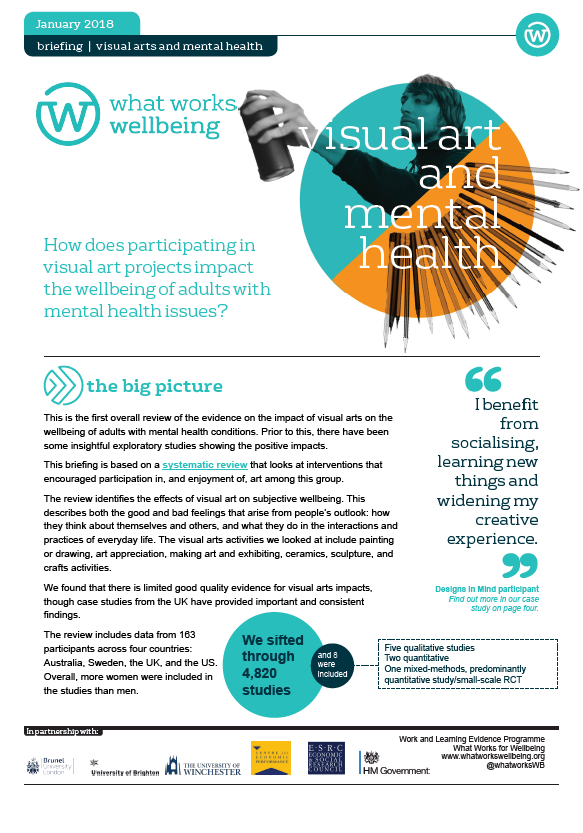Visual Art and Mental Health
Downloads

Intro
This is the first overall review of the evidence on the impact of visual arts on the wellbeing of adults with mental health conditions. Prior to this, there have been some insightful exploratory studies showing the positive impacts.
This briefing is based on a systematic review that looks at interventions that encouraged participation in, and enjoyment of, art among this group.
The review identifies the effects of visual art on subjective wellbeing. This describes both the good and bad feelings that arise from people’s outlook: how they think about themselves and others, and what they do in the interactions and practices of everyday life. The visual arts activities we looked at include painting or drawing, art appreciation, making art and exhibiting, ceramics, sculpture, and crafts activities.
We found that there is limited good quality evidence for visual arts impacts, though case studies from the UK have provided important and consistent findings.
The review includes data from 163 participants across four countries: Australia, Sweden, the UK, and the US. Overall, more women were included in the studies than men.
I benefit from socialising, learning new things and widening my creative experience.
What are the key findings?
Where you see the following symbols it indicates:
-
qualitative
-
quantitative
-
strongWe can be confident that the evidence can be used to inform decisions.
-
promisingWe have moderate confidence. Decision makers may wish to incorporate further information to inform decisions.
-
initialWe have low confidence. Decision makers may wish to incorporate further information to inform decisions.
Drawing representations of emotions, as in an exercise focused upon drawing mandalas, can reduce trauma for those suffering from post-traumatic stress disorder (PTSD)
Engaging in visual art activities can improve self-reported health and reduce symptoms of exhaustion for women with burnout.
Taking part in arts and crafts, such as ceramic painting, flower arranging, and assembling leather belts or models in plastic or wood, can improve quality of life for those suffering from PTSD.
Social enrichment and relationship building through doing art practices with others.
Achievement and appreciation from completing an art project, or simply regularly attending art sessions.
Using the intervention as a ‘stepping stone’ to taking part in other arts projects, or activities.
A distraction or escape from stigma or the trials of day-to-day life.
Doing and not talking, and establishing the basis of a new sense of identity when participants immerse themselves in a new and creative practice.
Promising results in relation to an improvement of confidence of people involved in visual arts.
Why should you care?
Evidence shows that visual arts activities, of various kinds, can reduce depression and anxiety and increase confidence and self-esteem.
How? Engagement with visual arts can support phased progress towards recovery, re-engagement with ‘everyday life’ and other people in a local culture and community. The creative process can help participants immerse themselves and escape from everyday anxieties and in some cases, thrive with the new identity of ‘artist’ or member.
It matters how activities are run. The most effective interventions provided: safe spaces where people did not feel stigmatised facilitation by empathetic teams of practitioners/researchers
So what?
Arts activities are important. We need to know more about which arts are effective in enhancing subjective wellbeing, for whom and in what contexts so that appropriate policy and practice decisions can be made.
What can you do next?
How does participating in visual arts impact the subjective wellbeing of adults (18-65 year olds) who have been diagnosed with a mental health condition? We are carrying out a review of all available evidence to find out.
If you work in an organisation that runs, funds, or works in any way with visual arts for adults experiencing mental health issues, we need your evaluation reports* – whether printed, digital or visual evidence – to help us tell the whole story.
Downloads
You may also wish to read the blog article on this document.
Downloads
You may also wish to read the blog article on this document.
![]()
[gravityform id=1 title=true description=true ajax=true tabindex=49]




